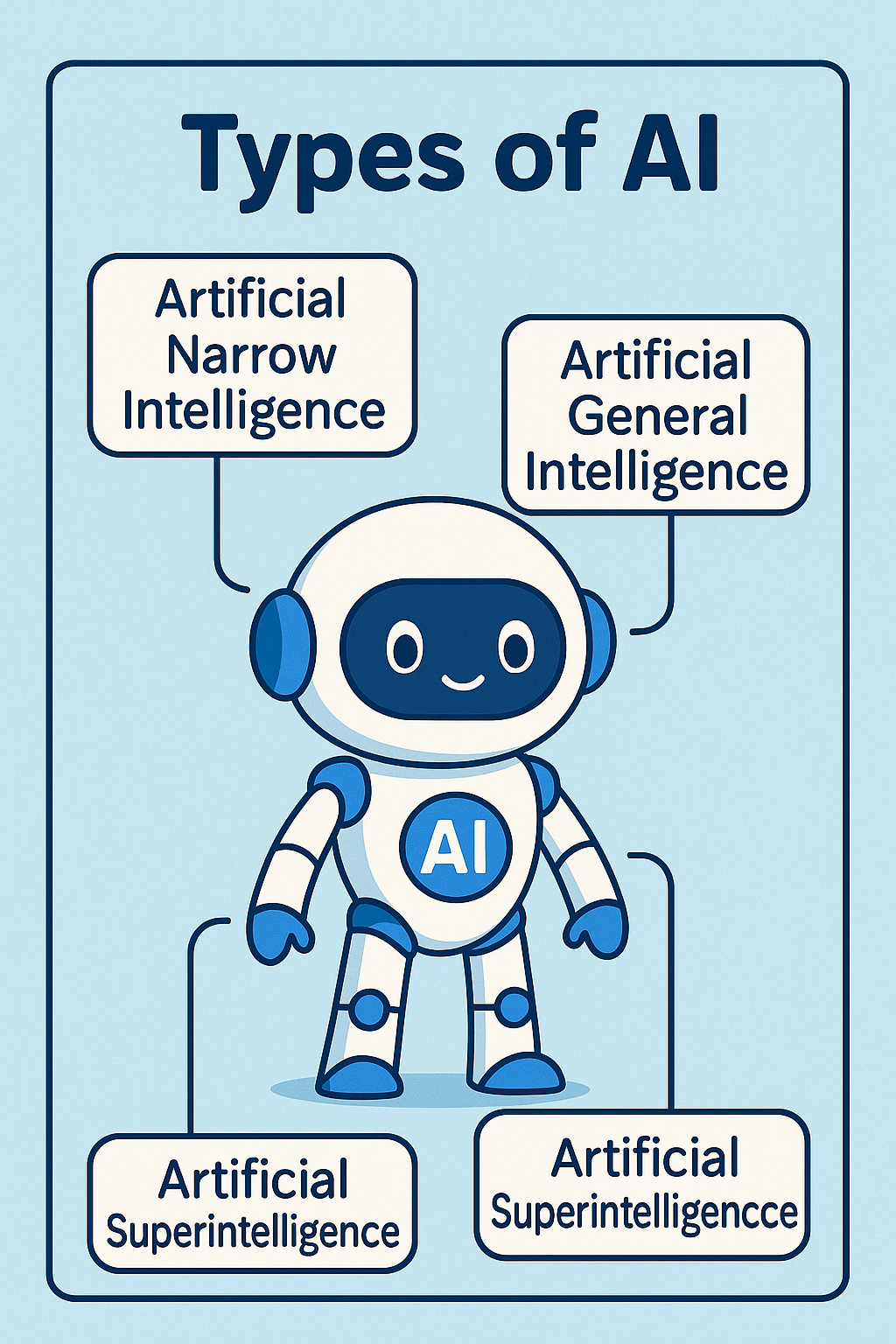
🌐 The Concept of Artificial Intelligence Explained Simply
The concept of artificial intelligence (AI) may sound futuristic or complicated, but it’s something we interact with more and more every day — from personalized recommendations on Netflix to chatbots answering your questions online. This article breaks down AI in a way that’s easy to understand, especially if you’re just starting your journey in tech or are simply curious.
We’ll walk through the basics of AI, its origins, key types, how it works, and what it means for our future. Whether you’re learning AI for the first time or trying to get a better sense of the big picture, this post will help you understand the concept of artificial intelligence in a beginner-friendly way.
📜 A Quick History of AI
The Pioneering Years
- 1940s-50s: British mathematician Alan Turing asks the revolutionary question: “Can machines think?”
- Proposes the Turing Test (1950): If a machine can hold a conversation indistinguishable from a human, it demonstrates intelligence.
- 1956: The term “Artificial Intelligence” is officially born at the Dartmouth Workshop, where early researchers aimed to build machines mimicking human reasoning.
The Rollercoaster of Progress
- 1960s-80s: Periods of enthusiasm (“AI summers”) followed by funding cuts and skepticism (“AI winters”) due to technological limitations.
- 1990s-2000s: Resurgence thanks to:
- Exponential growth in computing power
- Availability of massive datasets
- Breakthroughs in algorithms
The Modern AI Revolution
- 2010s-Present: AI becomes embedded in daily life through:
- Voice assistants (Siri, Alexa)
- Recommendation systems (Netflix, Spotify)
- Generative AI (ChatGPT, DALL·E)
💡 What Is Artificial Intelligence?
Core Definition
Artificial intelligence refers to machines or systems that can perform tasks typically requiring human intelligence, including:
- 🗣️ Natural Language Processing (NLP): Understanding/generating human language
- 👁️ Computer Vision: Recognizing images/objects
- 🧠 Learning & Adaptation: Improving from experience
- ⚖️ Decision-Making: Solving problems logically
“AI doesn’t possess consciousness but can simulate specific cognitive functions with remarkable accuracy.”
Everyday Examples
| AI Application | What It Does |
|---|---|
| Google Maps | Calculates optimal routes using real-time traffic data |
| Email Spam Filters | Learns to identify junk mail patterns |
| ChatGPT | Holds human-like text conversations |
⚙️ How AI Works: The Technical Breakdown
The 3-Step Process
- Input Phase
- Receives data (text, images, sensor readings)
- Processing Phase
- Uses algorithms to analyze patterns
- Machine Learning models improve through training
- Output Phase
- Delivers predictions, decisions, or generated content
Machine Learning Deep Dive
- Supervised Learning
- Trained on labeled datasets (e.g., “This image contains a cat”)
- Used in: Fraud detection, weather forecasting
- Unsupervised Learning
- Finds hidden patterns in unlabeled data
- Used in: Customer segmentation, anomaly detection
- Reinforcement Learning
- Learns via reward/punishment system
- Used in: Game-playing AI, robotics
🔍 Types of Artificial Intelligence
1. Narrow AI (Weak AI)
- Definition: Excels at single tasks within limited parameters
- Examples:
- Chess engines (like DeepBlue)
- Facial recognition systems
- Predictive text keyboards
2. General AI (Strong AI) [Theoretical]
- Definition: Human-level adaptability across diverse tasks
- Current Status: Doesn’t exist yet — major research challenge
3. Super AI [Hypothetical]
- Definition: Surpasses human intelligence in all domains
- Considerations: Raises philosophical/ethical questions about control
🎨 Generative AI: The Creative Frontier
What Makes It Special?
Unlike traditional AI that analyzes data, generative AI creates new content by learning patterns from massive datasets.
Popular Tools
| Type | Examples | Capabilities |
|---|---|---|
| Text | ChatGPT, Gemini | Writes essays, code, poetry |
| Image | DALL·E, Midjourney | Generates photorealistic art |
| Audio | MusicLM, OpenAI Jukebox | Composes original music |
| Video | Sora, RunwayML | Creates short video clips |
📱 Real-Life AI Applications Transforming Industries
Healthcare
- Diagnostics: AI analyzes medical scans with radiologist-level accuracy
- Drug Discovery: Accelerates identification of promising compounds
Finance
- Algorithmic Trading: Executes complex strategies at machine speed
- Credit Scoring: Uses alternative data for fairer assessments
Education
- Adaptive Learning: Customizes lesson difficulty in real-time
- Automated Grading: Provides instant feedback on assignments
Smart Cities
- Traffic Management: Optimizes signal timings to reduce congestion
- Energy Systems: Predicts demand to balance power grids
⚠️ Critical Challenges & Ethical Considerations
Technical Limitations
- Data Dependence: Requires massive, high-quality datasets
- Explainability: Complex models often function as “black boxes”
Societal Impacts
- Job Displacement: 14% of global workers may need to switch occupations by 2030 (McKinsey)
- Bias Amplification: Can perpetuate gender/racial prejudices in training data
Regulatory Landscape
- EU AI Act: First comprehensive legal framework for AI risk management
- Algorithmic Accountability: Growing demand for transparent AI systems
🧭 The Future of AI: What’s Next?
Emerging Trends
- Multimodal AI: Systems processing text, images, and audio simultaneously
- Neuromorphic Computing: Chips mimicking the human brain’s architecture
- AI Safety Research: Preventing harmful autonomous behaviors
Long-Term Possibilities
- Artificial General Intelligence (AGI): Most experts estimate 20-100 years away
- Human-AI Collaboration: Augmenting rather than replacing human capabilities
🏁 Final Thoughts: Your AI Journey Starts Here
Getting Started
- Learn the Basics: Free courses (Google AI Essentials, IBM AI Foundations)
- Hands-On Practice: Experiment with ChatGPT, Gemini, or Microsoft Copilot
- Stay Informed: Read more about AI ethics discussions and policy developments
“Understanding AI isn’t about becoming an expert overnight — it’s about building literacy for a world where AI touches every aspect of life.”
